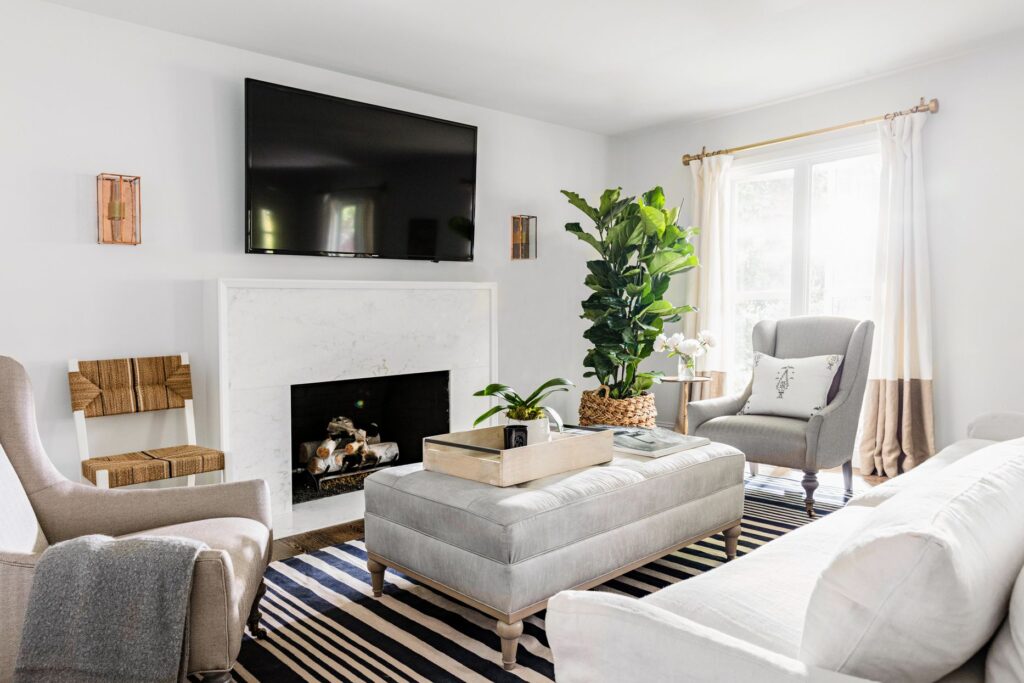
14 Living Room Furniture Layouts That Make the Most of Your Space
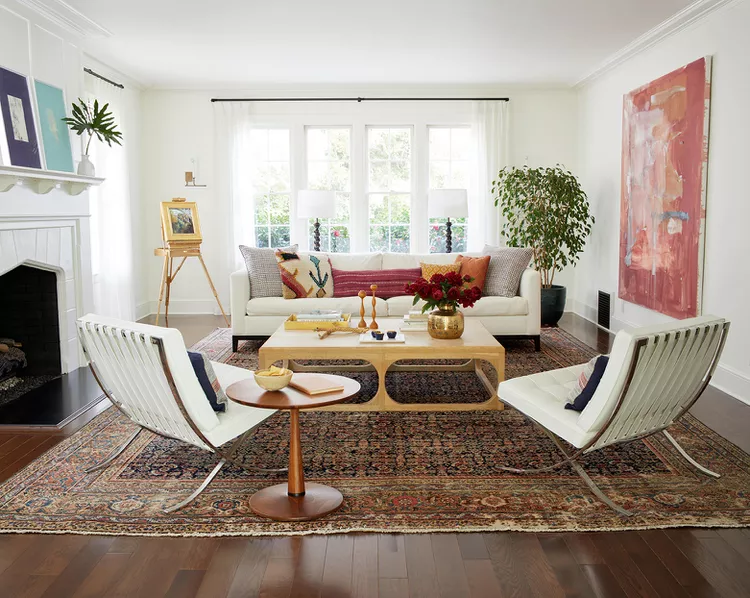
The arrangement of furniture in a living room can greatly impact the overall aesthetics and functionality of the space. Considerations such as room size, shape, and the primary activities that take place in the room should guide the placement of furniture. Here are a few common furniture arrangement options:
- Traditional Arrangement:
- Sofa centered against a wall.
- Chairs on either side of the sofa.
- Coffee table in front of the sofa.
- Symmetrical layout.
- Conversational Setup:
- Furniture arranged to encourage conversation.
- Sofa and chairs facing each other.
- Coffee table in the center.
- Suitable for social gatherings.
- L-Shaped Configuration:
- Sofa and chairs arranged to form an L-shape.
- Ideal for open-concept spaces.
- Defines separate zones within the room.
- Floating Furniture:
- Furniture placed away from walls.
- Creates a more open and airy feel.
- Suitable for larger rooms.
- Sectional Sofa Setup:
- L-shaped or U-shaped sectional sofas.
- Defines a cozy seating area.
- Maximizes seating space.
- Focal Point Emphasis:
- Arrangement focused around a central element (fireplace, TV, or large window).
- Furniture positioned to highlight the focal point.
- Multi-Functional Layout:
- Furniture arranged to serve multiple purposes.
- For example, a sofa bed for guests or a coffee table with storage.
- Asymmetrical Design:
- Furniture arranged in a more casual and eclectic manner.
- Creates visual interest with varying heights and shapes.
- Minimalist Arrangement:
- Selective and essential furniture pieces.
- Open and uncluttered layout.
- Circular Formation:
- Furniture arranged in a circular or semi-circular shape.
- Encourages inclusivity and conversation.
1.How to Place Furniture in a Living Room
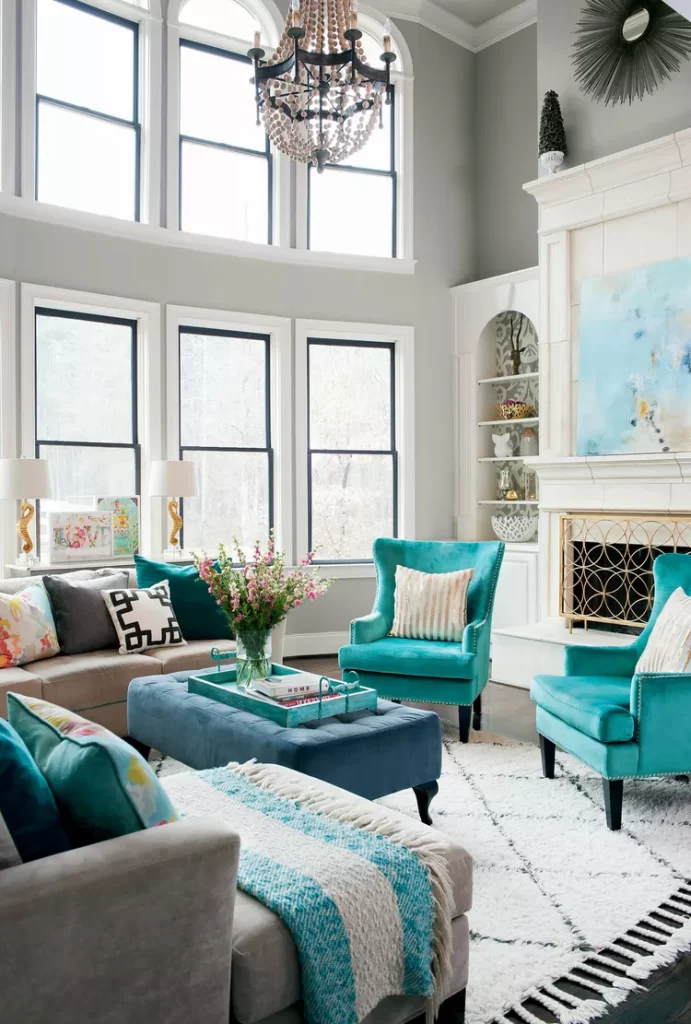
Starting with the largest piece of furniture, such as the sofa, provides a solid foundation for the arrangement. This approach ensures a well-balanced and functional layout. Here’s a breakdown of the steps you’ve highlighted:
- Start with the Largest Piece:
- Begin by placing the main seating element, usually the sofa or a prominent armchair.
- Orient it towards the room’s focal point, whether it’s a TV, fireplace, gallery wall, or window.
- Avoid Blocking Natural Light:
- If possible, refrain from placing the sofa directly in front of a window to maintain access to natural light.
- Position Smaller Seating Options:
- Place smaller seating elements, like chairs or love seats, either opposite or adjacent to the primary seating piece.
- This creates a cohesive and inviting seating arrangement.
- Accent Furniture Placement:
- Complete the arrangement with accent furniture, such as ottomans, coffee tables, end tables, and lamps.
- These elements add functionality and style to the space.
- Ensure Accessibility:
- Make sure each seat is within reach of at least one tabletop surface.
- This ensures convenience for placing items like drinks, books, or other belongings.
By following these steps, you not only establish a comfortable and visually appealing living room but also create a layout that promotes conversation and functionality. The inclusion of accent furniture adds a layer of design sophistication while serving practical purposes within the space. It’s a thoughtful approach to arranging furniture that considers both aesthetics and usability.
2.Small Living Room Layouts
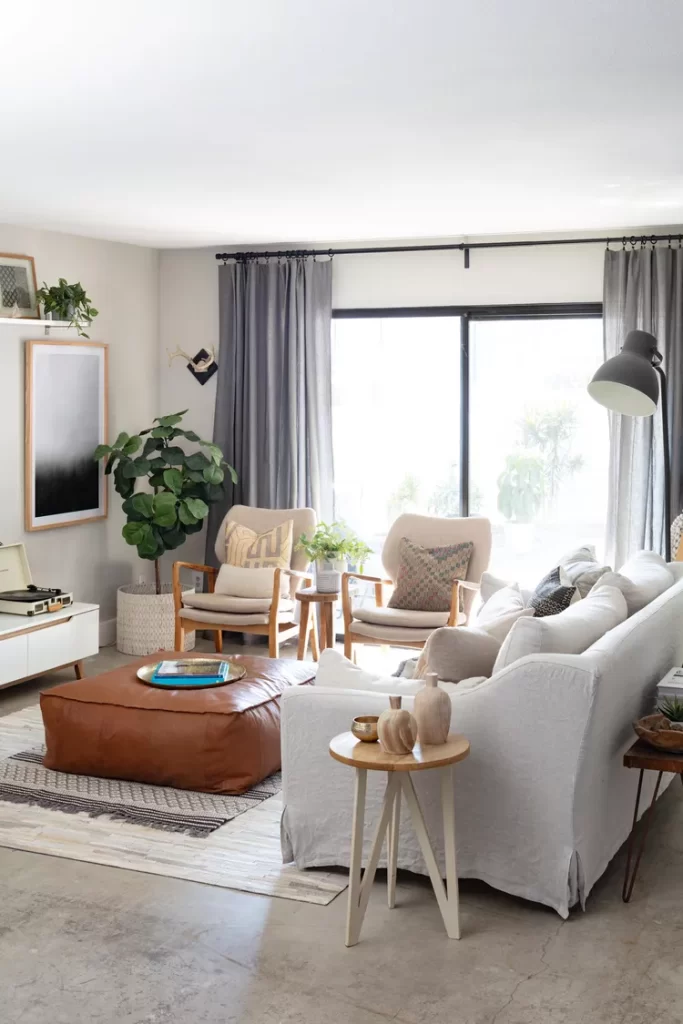
Pushing all furniture against the walls in a small living room can indeed make the space feel cramped and less inviting. Pulling furniture toward the center of the room is a great strategy to create a more open and balanced atmosphere. This approach has several benefits:
- Maximizes Space: By bringing furniture away from the walls, you avoid creating a “boxed-in” feeling. This can make the room appear larger and more spacious.
- Defines Zones: Arranging furniture toward the center allows you to define specific zones within the room. For example, you can create a seating area, a reading nook, or a conversation zone.
- Encourages Conversation: Placing furniture closer together promotes a more intimate and conversational setting. It’s easier for people to engage with each other when seating is arranged in a more clustered manner.
- Enhances Traffic Flow: Pulling furniture away from the walls can improve the flow of foot traffic through the room. This is particularly important in smaller spaces where efficient use of every square foot matters.
- Creates a Focal Point: When furniture is centered, it allows for the creation of a central focal point, such as a coffee table, a rug, or a piece of art. This draws attention to the center of the room and adds visual interest.
- Avoids Awkward Empty Spaces: Placing furniture against the walls may leave a large, empty space in the middle of the room, making it feel unbalanced and underutilized.
Ultimately, the goal in a small living room is to create a cozy and functional environment without emphasizing the limitations of the space. By pulling furniture toward the center, you can achieve a more harmonious and welcoming atmosphere.
3.Flexible Living Room Furniture Arrangements
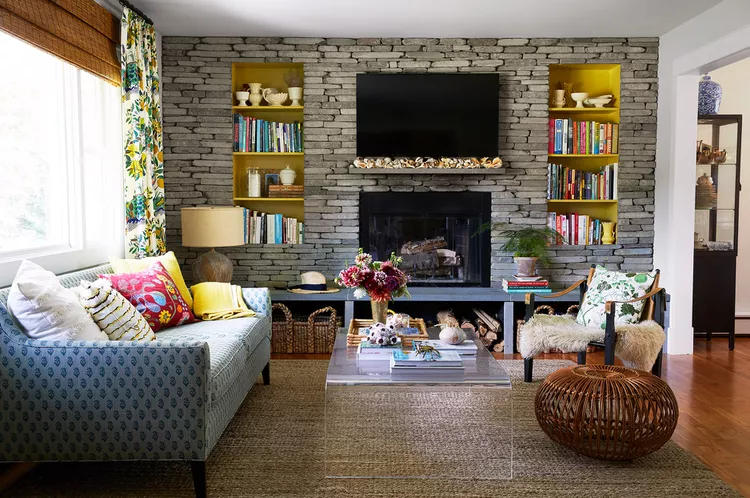
Furniture arrangement – flexibility. Adapting your living room layout to different occasions or needs is a smart approach, and it allows you to make the most out of your space. Here’s a breakdown of the key points you’ve emphasized:
- Versatile Furniture:
- Include lightweight chairs that can be easily moved to accommodate different arrangements.
- This flexibility ensures that seating can be adjusted based on the occasion, whether it’s a cozy family movie night or a gathering with friends.
- Utilizing Empty Corners:
- Make use of empty corners by adding versatile furniture like a lightweight chair.
- Empty corners can be transformed into functional spaces that contribute to the overall design and usability of the room.
- Multi-Functional Pieces:
- Incorporate furniture pieces that serve multiple functions.
- Ottomans or stools can act as side tables for drinks, additional seating for guests, or even footrests, offering a dynamic and adaptable living space.
- Easy Rearrangement:
- Grant yourself the freedom to rearrange furniture easily based on the needs of the moment.
- This ensures that your living room remains a dynamic and accommodating space that can evolve with your activities and preferences.
- Consider Occasional Furniture:
- Invest in occasional furniture that can be brought into play as needed.
- This could include folding chairs, poufs, or other portable seating options that can be conveniently stored when not in use.
By incorporating these principles, you create a living room that is not only aesthetically pleasing but also functional and responsive to your lifestyle. It allows for a dynamic environment where the furniture arrangement can be tailored to various activities and gatherings, ensuring that your living space remains adaptable and enjoyable.
4.How to Arrange Furniture on a Rug

The use of a large area rug is excellent for creating cohesion and visual unity in a seating group within a larger space. Here’s a breakdown of the key points you’ve highlighted:
- Large Area Rug for Unity:
- Opt for a large area rug to anchor and unify a seating group within a larger room.
- The rug acts as a visual focal point and helps define the boundaries of the seating area.
- All Key Pieces on the Rug:
- As a general rule, ensure that all key pieces of furniture within the seating group are placed on the rug.
- This creates a cohesive and well-integrated look, tying the furniture pieces together.
- Front Legs on the Rug:
- If the rug isn’t large enough to accommodate all furniture entirely, ensure that at least the front legs of each piece are on the rug.
- This partial placement maintains a sense of connection between the furniture and the rug, preventing the arrangement from appearing disjointed.
- Visual and Practical Considerations:
- The rug not only contributes to the visual aesthetics but also serves a practical purpose by providing a comfortable and defined space within the larger room.
- Size and Proportion:
- Consider the size of the room and the furniture when selecting the rug size to maintain proportionality and balance.
By following these guidelines, you enhance the overall design and functionality of the space. The use of a well-chosen, appropriately sized rug not only grounds the seating group but also adds texture, warmth, and a sense of completeness to the room. It’s a simple yet effective way to elevate the visual appeal of your living space.
5.Large Living Room Layout Ideas

As strategic furniture arrangement can indeed create a cozy and intimate atmosphere. Dividing the space into two conversation groupings with a clear path between them is an excellent approach. Here’s a breakdown of the key points you’ve highlighted:
- Divide into Two Conversation Areas:
- Split the long or large living room into two distinct conversation areas.
- This helps break up the expanse of the room, making it feel more intimate and purposeful.
- Create a Clear Path:
- Establish a path between the two conversation groupings.
- The path serves both practical and aesthetic purposes, allowing easy movement through the room while maintaining a sense of separation.
- Back of Sofa as a Divider:
- Position one sofa with its back to the path between the conversation areas.
- This helps visually underscore the separation between the two zones, defining each space while providing comfortable seating.
- Comfortable Scale:
- Ensure that the furniture pieces chosen for each conversation area are of a comfortable scale.
- Avoid overcrowding, and allow for ample space for movement and flow within each grouping.
- Consider Traffic Flow:
- Plan the arrangement with consideration for how people will move through and around each conversation area.
- This is crucial for maintaining functionality and preventing the space from feeling congested.
- Cozy and Intimate Atmosphere:
- By creating distinct conversation areas, you foster a sense of coziness and intimacy in each zone.
- Use area rugs, lighting, and decor elements to further enhance the ambiance of each grouping.
This approach not only addresses the challenges of long or large living rooms but also contributes to a well-designed and inviting space. It’s a thoughtful strategy that balances functionality with aesthetics, ensuring that the room feels both purposeful and welcoming.
6.Arrange Living Room Furniture for Conversation
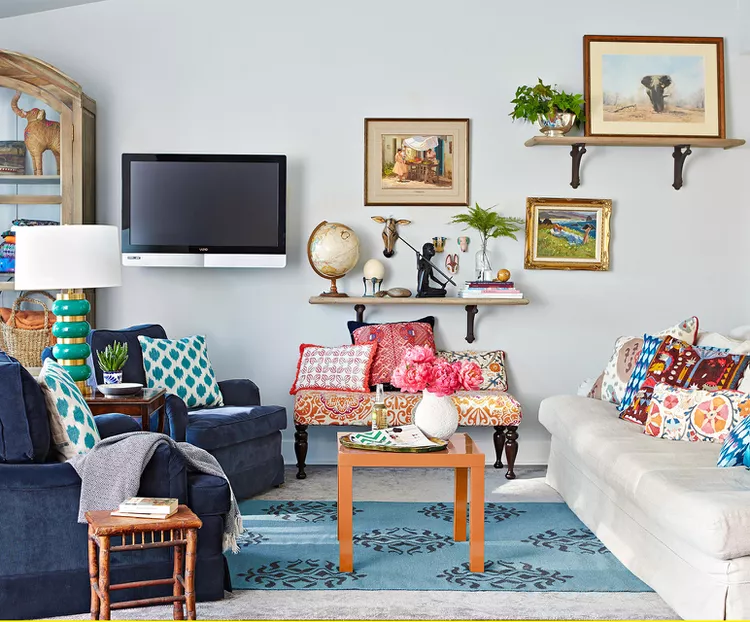
A furniture layout that facilitates conversation in a living room is spot-on. Prioritizing social interactions by pulling the seating close to the middle of the room and arranging them to face each other is an effective way to encourage communication and a sense of togetherness. Here’s a breakdown of the key points you’ve highlighted:
- Prioritize Conversation:
- If the primary use of the living room is for chats with family and friends, prioritize a layout that fosters conversation.
- Seating Arrangement:
- Pull the seating pieces closer to the middle of the room.
- Arrange the furniture in a way that faces each other, creating a conducive environment for communication.
- Central Coffee Table:
- Place a coffee table in the middle of the seating arrangement.
- The coffee table serves as a practical and central surface for drinks, snacks, and other items, making them easily accessible to everyone.
- Create a Cozy Atmosphere:
- Bringing the seating closer together and facing each other contributes to a cozy and intimate atmosphere.
- This arrangement encourages people to engage in conversations more comfortably.
- Consider Traffic Flow:
- Ensure that the furniture layout allows for easy movement and flow within the room.
- Avoid overcrowding, and maintain a balance between a welcoming atmosphere and practical functionality.
- Versatility for Different Occasions:
- The conversational layout is versatile and suitable for various occasions, whether it’s a casual family gathering or a more formal get-together with friends.
By implementing these principles, you create a living room that is not only aesthetically pleasing but also tailored to the social dynamics of your household. It’s a thoughtful and functional approach that enhances the overall enjoyment of the space for both everyday use and special occasions.
7.Furniture Arrangement for Lounging
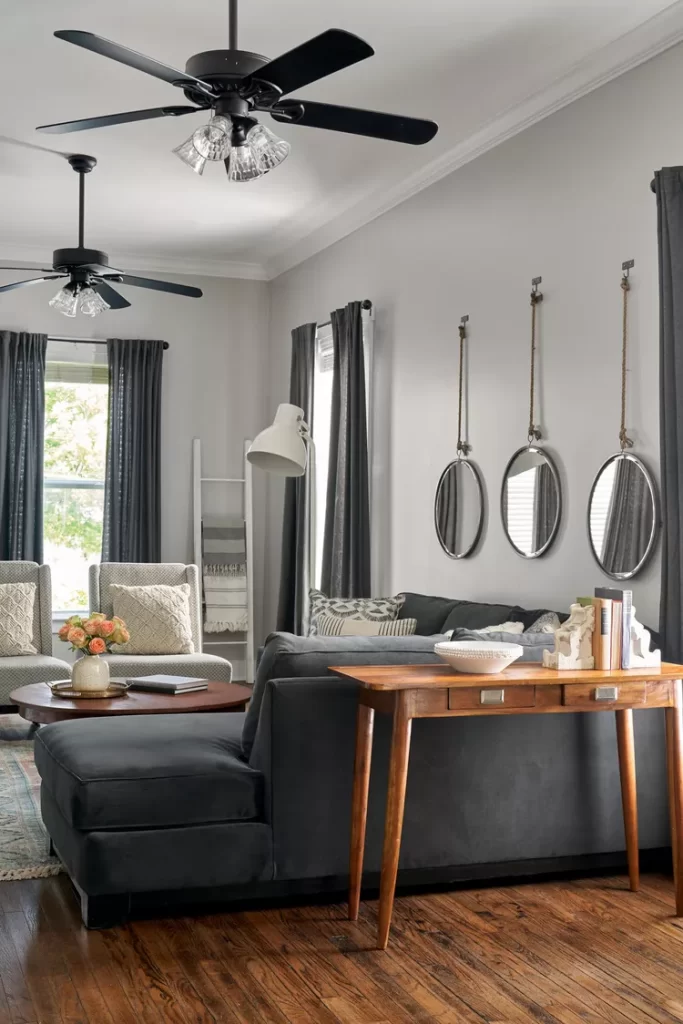
The use of a sectional sofa in living rooms where lounging and TV-watching are the main activities is both practical and well-suited for creating a comfortable and flexible seating arrangement. Here’s a breakdown of the key points you’ve highlighted:
- Flexible Seating with Sectional Sofa:
- Sectional sofas provide flexible and comfortable seating options, making them ideal for living rooms where lounging and TV-watching are the primary activities.
- Variety of Configurations:
- Sectionals come in various configurations, including armless chairs, love seats, ottomans, and chaises.
- This variety allows you to customize the sectional to fit your specific space and seating preferences.
- Cozy Seating for Several People:
- Sectional sofas are particularly well-suited for accommodating multiple people comfortably.
- The extended seating surface and typically L-shaped or U-shaped configurations create a cozy environment for group gatherings.
- Division of Larger Space:
- In larger living rooms, a sectional sofa can serve the dual purpose of providing comfortable seating and dividing the space.
- This can be especially useful in open-concept living areas.
- Integration with TV-Watching Setup:
- Arrange the sectional in a way that complements the TV-watching setup.
- Consider the placement of the TV and ensure that seating is oriented for optimal viewing.
- Versatile Use of Ottoman:
- Ottomans that often come with sectionals can serve as additional seating, footrests, or even as makeshift coffee tables.
- This versatility adds to the functionality of the living space.
By incorporating a sectional sofa, you create a central hub for relaxation and socializing in your living room. It not only offers ample seating but also contributes to the overall design aesthetic of the space. It’s a practical solution for households where comfort and a casual atmosphere are key priorities.
8.How to Place Furniture in a Living Room
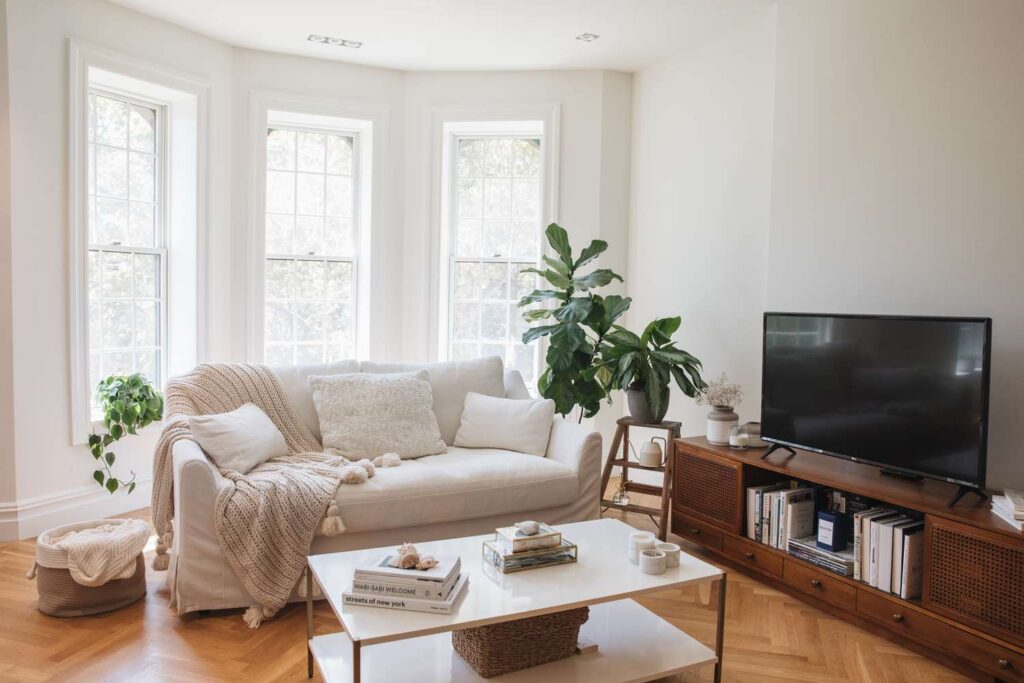
- Define the focal point: Identify the main focal point of the room, which could be a fireplace, a large window, or a TV. Arrange your furniture to highlight and complement this focal point.
- Create conversation areas: Arrange seating to encourage conversation. Consider grouping chairs and sofas in a way that allows people to face each other, promoting a comfortable and social atmosphere.
- Traffic flow: Ensure there’s a clear pathway for people to move through the room without obstructions. Avoid placing furniture in a way that disrupts the natural flow of foot traffic.
- Balance and symmetry: Achieve a sense of balance by distributing furniture evenly throughout the room. Symmetry can create a visually appealing arrangement, but asymmetry can work well too if done thoughtfully.
- Scale and proportion: Take into account the size of your furniture in relation to the size of the room. Avoid overcrowding or leaving too much empty space. Aim for a harmonious balance.
- Consider functionality: Think about the primary function of the room. If it’s a space for entertainment, ensure that the seating is arranged to provide a clear view of the TV or any other entertainment center.
- Accessorize: Add accessories such as coffee tables, side tables, and lamps to complement and enhance the overall arrangement. These items can also serve functional purposes.
- Experiment with layouts: Don’t be afraid to try different furniture arrangements to see what works best for your space. You can experiment with different layouts until you find the one that suits your preferences and lifestyle.
9.Symmetrical Living Room Layouts
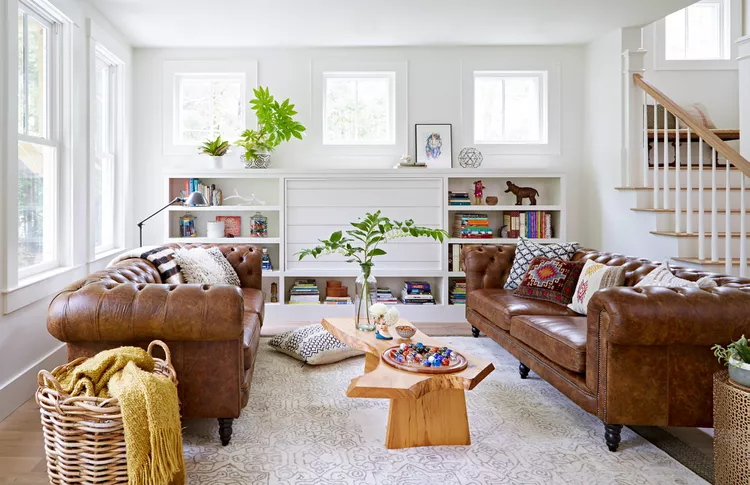
Absolutely, symmetrical arrangements can indeed create a sense of order and balance in a living room. Here are some additional tips for achieving a symmetrical look:
- Mirror-image placement: Place identical furniture pieces on either side of a central axis. For example, if you have a fireplace or a large window as the focal point, position matching sofas or chairs on each side.
- Use pairs: Opt for pairs of identical furniture pieces, such as two matching sofas, chairs, or end tables. This creates a cohesive and visually pleasing look.
- Center focal point: If there’s a central element like a coffee table or an ottoman, arrange furniture around it in a symmetrical manner. This can create a harmonious and balanced feel.
- Balance with accessories: Even if your furniture isn’t an exact match, you can achieve symmetry through the use of accessories. Place matching lamps, artwork, or decorative items on either side of the room to maintain a sense of balance.
- Rug placement: If you have a large rug in the room, ensure that it’s centered and that furniture is arranged symmetrically around it. This can anchor the space and contribute to the overall balance.
Remember, while symmetry can create a classic and formal look, it’s not the only option. Some people prefer a more eclectic or casual feel, and asymmetrical arrangements can work well in those cases. It ultimately depends on your personal style and the atmosphere you want to create in your living room.
10.Focus on the View

Definitely, focusing on a central point in the room, often referred to as the focal point, is a key aspect of effective living room arrangement. Here are some tips to enhance the arrangement around a focal point, such as a fireplace:
- Main seating orientation: Place the main seating piece, such as a sofa or sectional, facing the focal point. This ensures that the primary seating area is centered around the most prominent feature in the room.
- Symmetry around the focal point: Arrange secondary seating pieces, such as chairs or loveseats, around the main seating piece in a way that complements the focal point. This creates a balanced and cohesive look.
- Balance with furniture: Ensure that the size and scale of the furniture match the scale of the focal point. This helps in maintaining visual harmony in the room.
- Consider seasonal changes: As you mentioned, be flexible with your arrangement. In the summer or during different occasions, you can experiment with rearranging furniture to highlight different features, such as a beautiful view outside the French doors.
- Enhance with accessories: Use accessories like artwork, mirrors, or decor items to accentuate the focal point. This draws attention to the central feature and enhances the overall design.
- Functional layout: Consider the functionality of the space. If the room is used for entertainment, ensure that seating is arranged to provide a good view of the focal point, whether it’s a fireplace, TV, or another central element.
- Create conversation zones: Arrange furniture to facilitate conversation. Group seating pieces together to encourage interaction and a social atmosphere, especially around the focal point.
Remember, the key is to make the focal point the highlight of the room and arrange the furniture in a way that complements and emphasizes that feature. Additionally, being open to seasonal changes or adjusting the arrangement for different occasions can add versatility to your living room design.
11.Open Living Room Layout Ideas
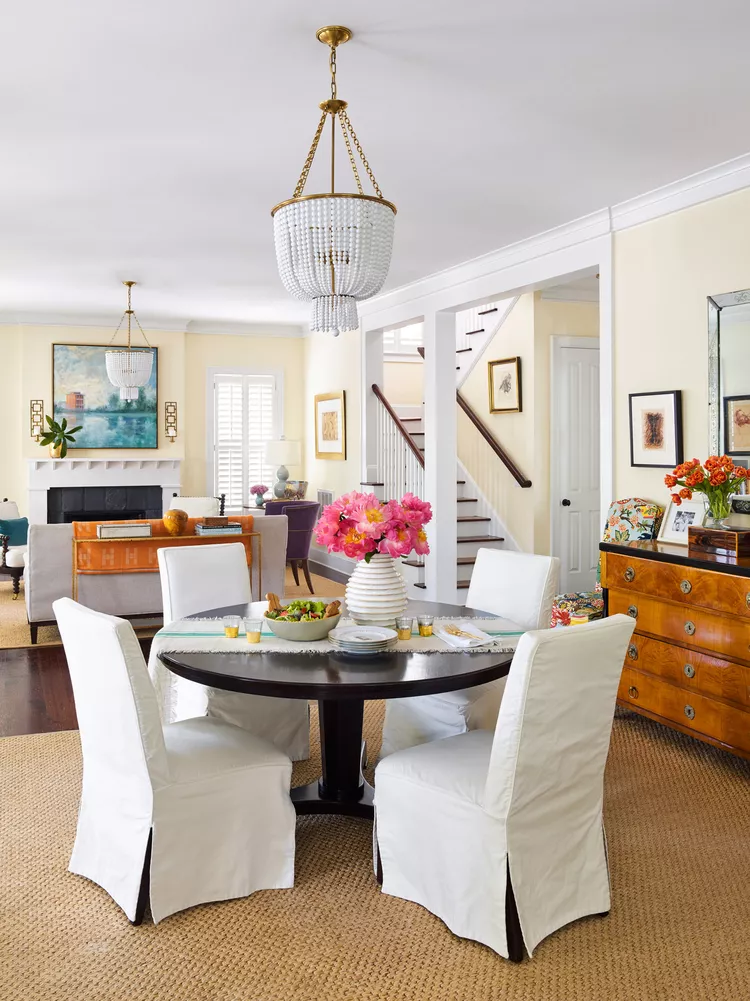
Creating distinct activity zones in an open-concept living room is a great strategy to maximize the functionality and appeal of the space. Here are some additional tips for effectively dividing the space into different zones:
- Define zones with furniture placement: Strategically position furniture to delineate specific areas. For example, use a rug to anchor the seating arrangement around the fireplace, and another rug to define the dining or game area.
- Consistent color scheme: Maintain a cohesive color scheme throughout the various zones to create visual continuity. This can help tie together the different areas of the open space.
- Flexible furniture: Opt for furniture pieces that can be easily moved or rearranged, especially in a multifunctional space. This allows you to adapt the layout based on different activities or needs.
- Use of screens or room dividers: Consider using decorative screens, bookshelves, or other room dividers to physically separate different zones while maintaining an open feel. These elements can add visual interest and functionality.
- Lighting for each zone: Install lighting fixtures that are specific to each zone. Pendant lights over a dining table, floor lamps in a reading nook, and recessed lighting in the seating area can define and enhance each space.
- Traffic flow: Ensure there’s enough space for easy movement between the different zones. Avoid overcrowding any one area and maintain a logical flow through the room.
- Multifunctional furniture: Select furniture that serves dual purposes, such as a coffee table that can also be used for board games, or a sofa with storage space. This helps optimize the use of each zone.
- Create visual connections: While dividing the space, maintain visual connections between the zones. This can be achieved through coordinating decor elements or maintaining a consistent design theme.
By carefully planning the arrangement of furniture, considering the use of each zone, and incorporating design elements that tie everything together, you can create a cohesive and inviting open-concept living space that serves various functions seamlessly.
12.Divide a Living Room with Furniture
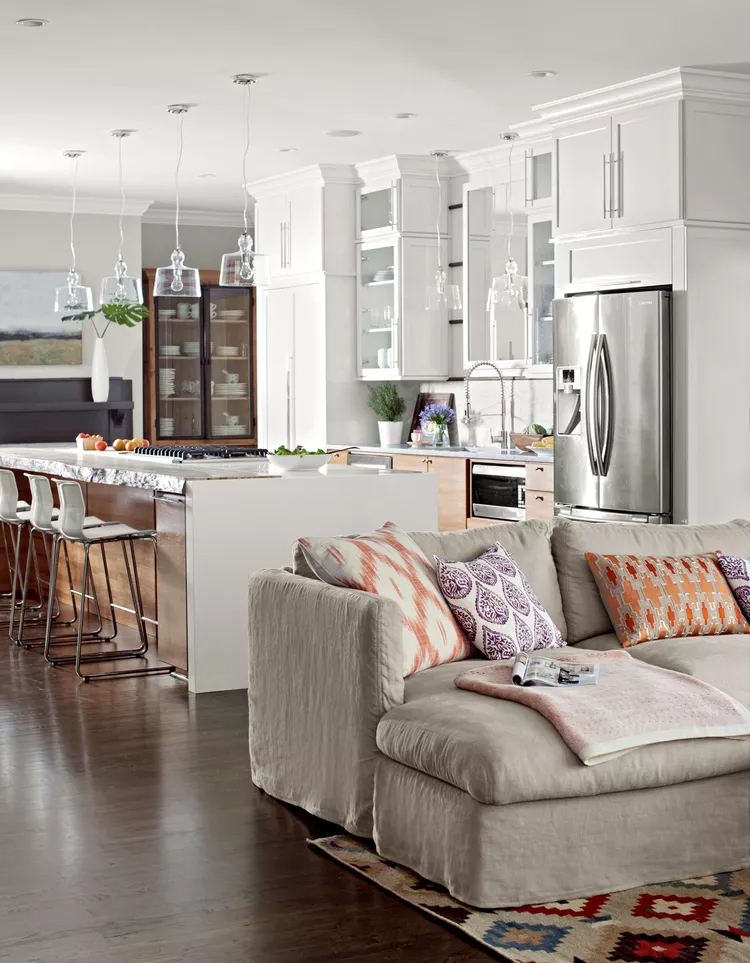
Certainly, dividing a large living and dining space into separate zones through furniture placement can help define specific areas and create a more organized and purposeful layout. Here are some tips based on your description:
- Orientation of the sofa: Placing the sofa facing away from the dining room is an excellent way to define a conversation area. This creates a clear visual separation between the living and dining zones.
- Use a rug to anchor the living room: To further delineate the living room area, consider placing a rug under the sofa and surrounding seating. The rug acts as a visual anchor, defining the boundaries of the conversation zone.
- Arrange living room furniture closer together: Bring the living room furniture, including the sofa, chairs, and coffee table, closer together. This arrangement fosters a sense of intimacy and coziness within the larger space.
- Consider a sectional sofa: If the room allows, consider using a sectional sofa. This type of seating arrangement naturally creates a defined space for conversation while maximizing seating capacity.
- Coordinate color schemes: Maintain a cohesive color scheme or theme throughout the living and dining areas. This helps tie the two zones together while still allowing each area to have its distinct character.
- Define the dining area: Use the dining table and chairs to establish the dining zone. Consider a statement light fixture or a rug beneath the dining table to further distinguish this space from the living area.
- Create flow with furniture placement: Ensure there’s a logical flow between the different zones, allowing for easy movement between the living and dining areas. Avoid placing furniture in a way that obstructs natural traffic paths.
- Use multifunctional furniture: Incorporate furniture that serves multiple purposes. For instance, a console table behind the sofa can act as a visual divider and provide additional storage or display space.
- Strategic use of tall furniture or bookshelves: If appropriate for the style of the room, tall furniture or bookshelves can be strategically placed to visually separate the living and dining areas while maintaining an open feel.
By carefully arranging furniture, utilizing visual cues like rugs and lighting, and maintaining a sense of unity through color and design elements, you can successfully divide a large living and dining space into separate and purposeful zones.
13.Small Living Room Layout Ideas
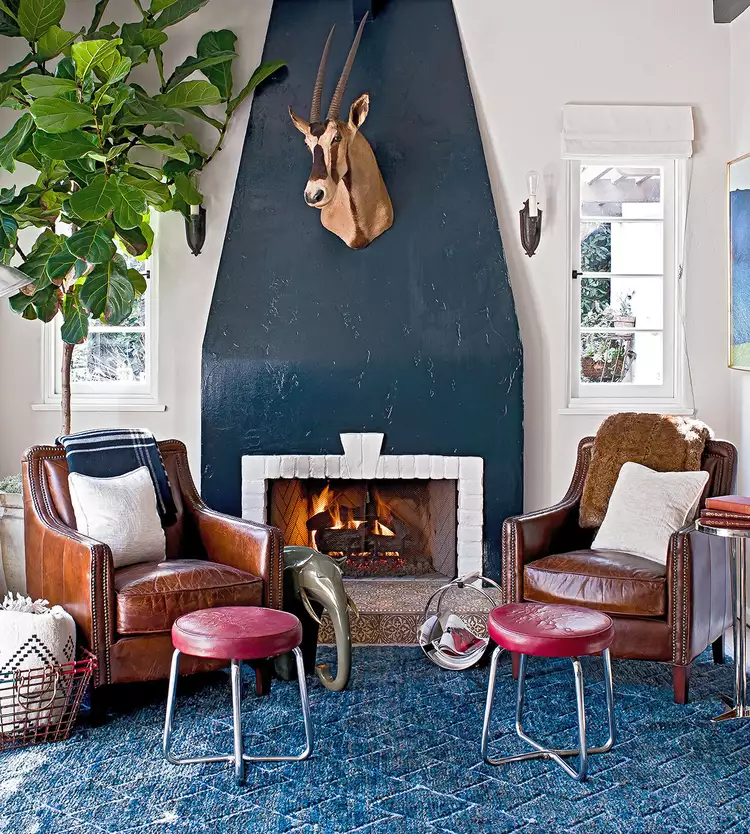
Decorating a small living room requires thoughtful consideration of furniture scale to maximize space and create a more open feel. Here are some additional tips to scale down furniture choices for a smaller living room:
- Choose streamlined and compact furniture: Opt for furniture with sleek lines and smaller proportions. This helps to prevent the room from feeling overcrowded. Look for sofas, chairs, and tables that have a more minimalist design.
- Consider armless chairs: Armless chairs take up less visual and physical space, making them an excellent choice for a small living room. They can also be more versatile and easily rearranged.
- Use open-leg furniture: Furniture with exposed legs creates a sense of openness by allowing light to pass through, making the room appear larger. This is especially effective for sofas and chairs.
- Multi-functional furniture: Select furniture pieces that serve multiple purposes. For example, choose a coffee table with storage space or a sofa bed that can double as a guest bed. This helps maximize functionality in a limited space.
- Light-colored upholstery: Lighter colors tend to reflect more light, creating an airy and open atmosphere. Consider choosing furniture with light-colored upholstery to visually expand the space.
- Modular or sectional seating: Modular or sectional seating can be arranged in various configurations to fit the layout of the room. This flexibility is beneficial for small spaces, allowing you to adapt the arrangement as needed.
- Wall-mounted or floating furniture: Consider wall-mounted shelves, cabinets, or entertainment units to free up floor space. This not only provides storage but also contributes to the illusion of a larger room.
- Opt for petite stools: As you mentioned, using petite stools instead of bulkier ottomans is a smart choice. Stools can be easily moved around and tucked away when not in use, offering flexibility in a small living room.
- Use mirrors strategically: Mirrors reflect light and create the illusion of space. Consider placing a large mirror on one wall to visually expand the room and enhance the feeling of openness.
- Declutter and prioritize: Keep only essential furniture items to prevent the room from feeling cramped. Prioritize the pieces that are most important for comfort and function in a smaller space.
By implementing these strategies, you can create a comfortable and visually appealing small living room that feels more spacious and open.
14.L-Shaped Living Room Layout Ideas

Arranging a sofa and a love seat in an L-shaped configuration around a large coffee table is a classic and comfortable setup for a living room. Here are some additional tips to enhance this arrangement:
- L-Shaped Configuration: Position the sofa and love seat in an L-shaped arrangement, with one piece extending along one wall and the other along the adjacent wall. This layout is conducive to conversation and creates a cozy atmosphere.
- Large Coffee Table: Place a sizable coffee table in the center of the seating arrangement. This table serves as a practical surface for drinks, snacks, and decor, and it visually anchors the seating pieces.
- End Table in the Corner: In the corner where the sofa and love seat meet, add an end table to fill the space. The Better Homes & Gardens Round Marble End Table you mentioned is a great choice, providing both functionality and style.
- Table Lamp: On the end table, place a stylish table lamp to add ambient lighting to the corner. This not only enhances the aesthetics but also contributes to a cozy and well-lit atmosphere for reading or relaxing.
- Single Chair: On the opposite side of the sofa and love seat grouping, add a single chair. This chair can be easily moved closer to the conversation when needed, offering flexibility in seating arrangements.
- Create a Reading Nook: If space permits, use the single chair and end table to create a reading nook. Add a small bookshelf or a magazine rack nearby for easy access to reading materials.
- Coordinate Furniture Styles: Ensure that the style and color of the sofa, love seat, and additional chair complement each other. Coordinated furniture pieces contribute to a cohesive and harmonious look in the living room.
- Accent Pillows and Throws: Enhance the comfort and visual appeal of the seating arrangement by adding accent pillows and throws to the sofa, love seat, and chair. This not only adds color and texture but also makes the space inviting.
- Consider Area Rugs: Define the seating area by placing an area rug underneath the sofa, love seat, and coffee table. This helps visually unify the arrangement and adds an extra layer of comfort.
- Personalize with Decor: Add personal touches to the end table and coffee table with decorative items such as candles, vases, or small sculptures. This adds character to the space and makes it feel more like home.
